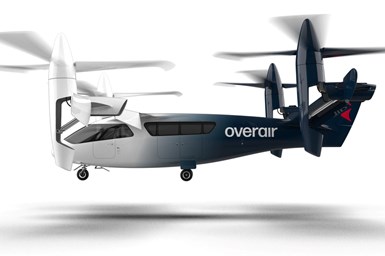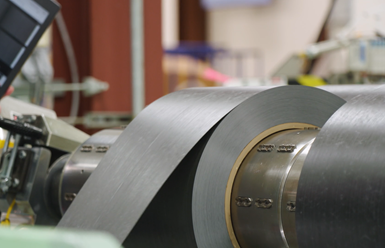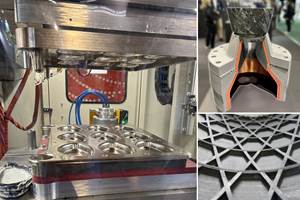“We’re seeing a lot of interest and investment in eVTOLs [electric vertical takeoff and landing vehicles] in general, but we want to introduce a vehicle that is uniquely designed for sustainable, quiet, aerial ridesharing,” explains Lindsay Miller, lead airframe manufacturing engineer at Overair (Santa Ana, Calif., U.S.).
Overair was founded in 2020 by aerospace industry veterans Abe Karem and Ben Tigner, both of whom also lead military-focused tiltrotor developer Karem Aircraft (Lake Forest, Calif., U.S.). With the new company, the founders aimed to leverage their previous technology and intellectual property (IP) into the consumer market and urban air mobility (UAM).
Overair plans to enter the market with Butterfly, a six-seater, piloted urban ridesharing aircraft designed with space and capacity for baggage or cargo. The battery-powered eVTOL is designed for a range of up to 100 miles and a maximum speed of 200 miles per hour. The current goal is to build a flight prototype vehicle for testing in the second half of 2023.
Despite starting during the beginning of the COVID-19 pandemic in 2020, Miller says that the company has been making steady progress toward this goal. For example, on June 14, the company announced that it had received $145 million in funding from Hanwha Systems and Hanwha Aerospace (both in Seoul, South Korea), which will be used to develop the first flight prototype of Butterfly.
Even more recently, on July 7, the company announced a partnership with carbon fiber materials supplier Toray Composite Materials America Inc. (Toray CMA, Tacoma, Wash., U.S.), whose T1100/3960 carbon fiber/epoxy prepreg will be used to build major airframe components on the flight test vehicle, such as portions of the fuselage and wings, as well as the rotor blades.
Jeff Cross, director of aerospace business development at Toray CMA, explains, “Karem originally used the T1100/3960 materials for a DARPA/Army project, so down-selecting T1100/3960 for Butterfly was a natural progression.” Toray’s 3960 is said to be a highly toughened 350°F/177°C cure epoxy resin with a glass transition temperature (Tg) of 400°F/204°C, while the Torayca T1100 intermediate modulus plus (IM+) carbon fiber is claimed to be the highest tensile strength fiber available.
Designing Butterfly: High-efficiency, low-noise, composites-intensive
“The end game is introducing a clean, quiet transportation network, utilizing Butterfly as the vehicle to make that happen,” Miller says. “We believe it will be the quietest aircraft of its kind. Especially when you’re talking about urban air mobility, that’s going to be a really important factor and I think it’ll be one of our key advantages.”
Overair is commencing work with NASA, she says, to confirm its flight and sound models, though the actual decibel levels will need to be tested and verified once the prototype is built.
One of the main noise-reduction features is the vehicle’s four relatively large, relatively slow-moving propellers, featuring three composite blades each. Alan Buehne, senior aerostructures engineer at Overair, explains that these large propellers were developed for high efficiency for larger payloads as the first goal. “We designed the propellers to have low disc loading, which means it has low weight for the total area of the propeller. Lower disc loading tends to correlate with higher efficiency, and also lower noise.”
A main factor in the propellers’ — and overall aircraft’s — low weight and high efficiency will be the carbon fiber/epoxy prepreg used in the flight prototype. Buehne says, “It’ll be a multi-material aircraft, incorporating some metals and other composite materials as well, but we’ve decided to use Toray’s T1100 for many of the large, visible airframe components, such as large portions of the fuselage and wings.”
Overair recently completed full-scale testing of Butterfly’s propulsion system, and the propeller will be showcased at the Farnborough International Air Show from July 18-22 in Farnborough, England.
Buehne explains that the Overair team decided to go with T1100, an intermediate modulus fiber, for parts that needed high stiffness without sacrificing properties like strength and damage tolerance. “You can get more stiffness with a high modulus fiber, but you’re giving up some of the strength of the fiber and you get lower performance from the resin. T1100 gives us a good balance of the properties that we need.” He adds, “We chose T1100 for components that require a certain amount of stiffness to avoid dynamic resonance issues.” For different components, the material is used as either a unidirectional [UD] tape or a fabric. Additional benefits of T1100 materials, Cross notes, include fiber performance and ease of processing.
According to Cross, Toray CMA is funding a five-batch allowable project to generate data to support design efforts for Butterfly. Buehne notes that the support Overair has received from Toray CMA has been helpful throughout the design process so far. “They’ve been pretty willing to develop — and then share — their own data set, and that’s not always the case. It’s helpful to not have to shoulder the entire burden of characterizing the material.”
Currently, Overair is working to certify Butterfly’s design per FAA standards. The first prototype will be an unmanned aircraft for flight tests, aiming for testing in the second half of 2023 at Overair’s Victorville, Calif., U.S. site.
To manufacture the flight vehicle itself, Miller explains that Overair recently acquired a new facility adjacent to its existing headquarters for use in manufacturing its aircraft. Each composite part is laid up by hand and cured via autoclave. Tooling is developed either in-house or by one of Overair’s manufacturing partners.
“Overall, what we’re developing with Butterfly is not only a safe aircraft, but also one that has six seats, an appropriate range, and something that’s really quiet for the high-density urban environments where we think urban ridesharing is going to be in the highest demand for first rollout,” Miller says.
Related Content
Combining multifunctional thermoplastic composites, additive manufacturing for next-gen airframe structures
The DOMMINIO project combines AFP with 3D printed gyroid cores, embedded SHM sensors and smart materials for induction-driven disassembly of parts at end of life.
Read MoreJeep all-composite roof receivers achieve steel performance at low mass
Ultrashort carbon fiber/PPA replaces steel on rooftop brackets to hold Jeep soft tops, hardtops.
Read MorePEEK vs. PEKK vs. PAEK and continuous compression molding
Suppliers of thermoplastics and carbon fiber chime in regarding PEEK vs. PEKK, and now PAEK, as well as in-situ consolidation — the supply chain for thermoplastic tape composites continues to evolve.
Read MoreJEC World 2024 highlights: Thermoplastic composites, CMC and novel processes
CW senior technical editor Ginger Gardiner discusses some of the developments and demonstrators shown at the industry’s largest composites exhibition and conference.
Read MoreRead Next
Developing bonded composite repair for ships, offshore units
Bureau Veritas and industry partners issue guidelines and pave the way for certification via StrengthBond Offshore project.
Read More“Structured air” TPS safeguards composite structures
Powered by an 85% air/15% pure polyimide aerogel, Blueshift’s novel material system protects structures during transient thermal events from -200°C to beyond 2400°C for rockets, battery boxes and more.
Read MorePlant tour: Daher Shap’in TechCenter and composites production plant, Saint-Aignan-de-Grandlieu, France
Co-located R&D and production advance OOA thermosets, thermoplastics, welding, recycling and digital technologies for faster processing and certification of lighter, more sustainable composites.
Read More

.jpg;width=70;height=70;mode=crop)
























